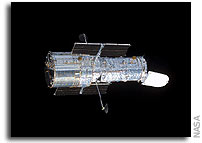NASA Hubble Space Telescope Daily Report #4442

Notice: Due to the conversion of some ACS WFC or HRC observations into WFPC2, or NICMOS observations after the loss of ACS CCD science capability in January, there may be an occasional discrepancy between a proposal’s listed (and correct) instrument usage and the abstract that follows it.
HUBBLE SPACE TELESCOPE DAILY REPORT # 4442
– Continuing to collect World Class Science
PERIOD COVERED: UT September 06, 2007 (DOY 249)
OBSERVATIONS SCHEDULED
WFPC2 11034
WFPC2 Closeout Photometric Characterization
The standard star GRW+70D5829 is observed in filter and chip combinations that were not included in photometric calibration programs from 2005, 2006, and 2007. These observations are needed to complete a library of recent standard star observations taken in all filter and chip combinations before WFPC2 is decommissioned in SM4. {Linear Ramp and Polarizer filters are covered in a separate proposal.} These observations, along with other recent standard star observations, will be used to study long-term throughput.
WFPC2 11038
Narrow Band and Ramp Filter Closeout
These observations are to improve calibration of narrow band and ramp filters. We also test for changes in the filter properties during WFPC2’s 14 years on-board HST.
WFPC2 11084
Probing the Least Luminous Galaxies in the Local Universe
We propose to obtain deep color-magnitude data of eight new Local Group galaxies which we recently discovered: Andromeda XI, Andromeda XII, and Andromeda XIII {satellites of M31}; Canes Venatici I, Canes Venatici II, Hercules, and Leo IV {satellites of the Milky Way}; and Leo T, a new “free-floating” Local Group dwarf spheroidal with evidence for recent star formation and associated H I gas. These represent the least luminous galaxies known at *any* redshift, and are the only accessible laboratories for studying this extreme regime of galaxy formation. With deep WFPC-2 F606W and F814W pointings at their centers, we will determine whether these objects contain single or multiple age stellar populations, as well as whether these objects display a range of metallicities.
WFPC2 11100
Two new `bullets’ for MOND: revealing the properties of dark matter in massive merging clusters
The principal objective of this proposal is to study the physical nature of dark matter by using two, massive, newly-identified merging clusters of galaxies. As shown by the pioneering example of the “bullet cluster” {1E0657-56}, such systems are ideal laboratories for detecting dark matter and distinguishing between cold dark matter {CDM} and other scenarios {e.g. self-interacting dark matter}. Our limit on the self-interaction cross-section of dark matter relies on the assumption of a normal pre-merger mass-to-light ratios, and a small impact parameter during the collision of the two clusters. In order to mitigate any possible systematic effects, it is vital to extend this work to other, similar systems. With detailed observations of new systems, the systematic uncertainties in the dark matter cross section calculations can be improved substantially, allowing us to move from rough order of magnitude estimates to measurements with quantifiable uncertainties that can be compared usefully with the predictions from numerical simulations. Our targets are two extraordinary, high-redshift, merging galaxy clusters recently discovered by the Massive Cluster Survey {MACS}. This survey is by far the best matched to this study, since it selects medium redshift {optimal for gravitational lensing studies} and X-ray luminous {hence massive} objects. We have selected the best candidates with clear evidence for considerable offsets between the hot X-ray emitting gas and optically luminous stellar material. The two most striking examples are the targets of this proposal. To pin down the position of the dark matter component we require high resolution, absolutely calibrated mass maps. The combination of weak and strong lensing measurements is needed to attain this goal. This can only be achieved with the excellent resolving power of the HST {in combination with wide-field, multicolor Subaru data already in hand}. We therefore request multicolor HST/WFPC2 observations of the two merging clusters. The combination of constraints from multiply lensed images {identified via morphology and color information} and high-resolution weak lensing data will allow us to construct, self-consistently, their mass distribution from the very centers to the outskirts. Gravitational lensing thus provides a unique tool transforming these clusters into dark matter laboratories. They will supply us with answers as to the nature and properties of dark matter, and how it shapes galaxies and galaxy clusters and their evolution through cosmic time.
FLIGHT OPERATIONS SUMMARY:
Significant Spacecraft Anomalies: (The following are preliminary reports of potential non-nominal performance that will be investigated.)
HSTARS: (None)
COMPLETED OPS REQUEST: (None)
COMPLETED OPS NOTES: (None)
SCHEDULED SUCCESSFUL FGS GSacq 05 05 FGS REacq 08 08 OBAD with Maneuver 26 26
SIGNIFICANT EVENTS: (None)








